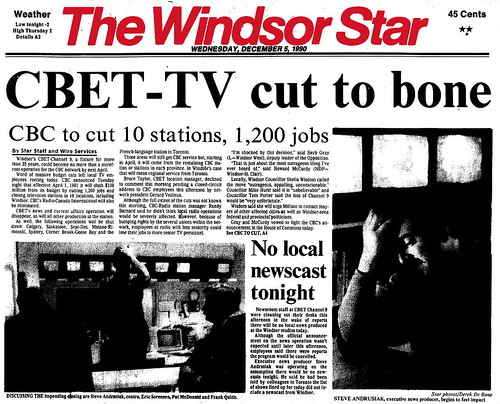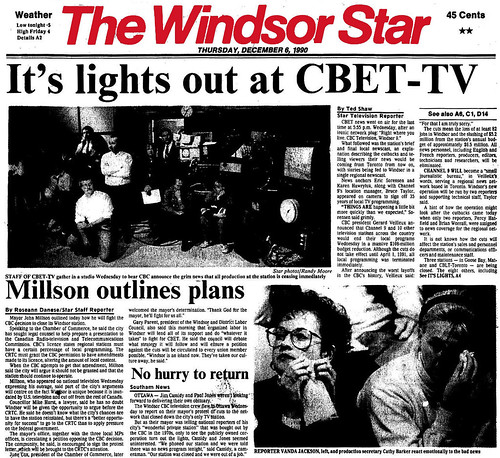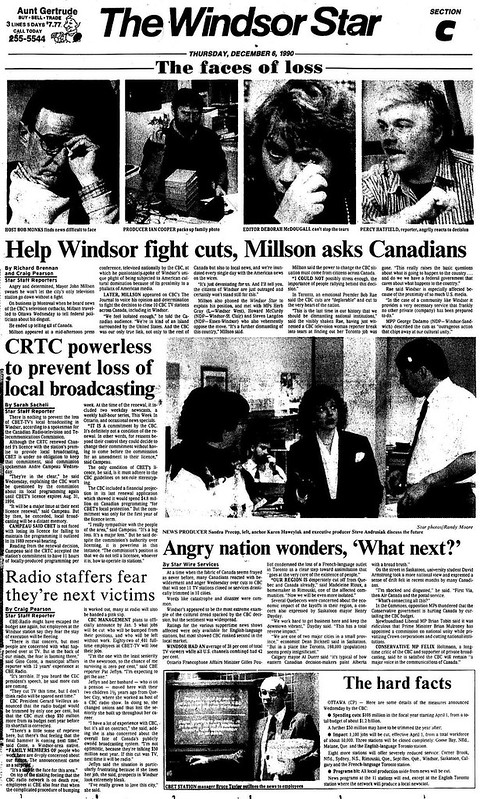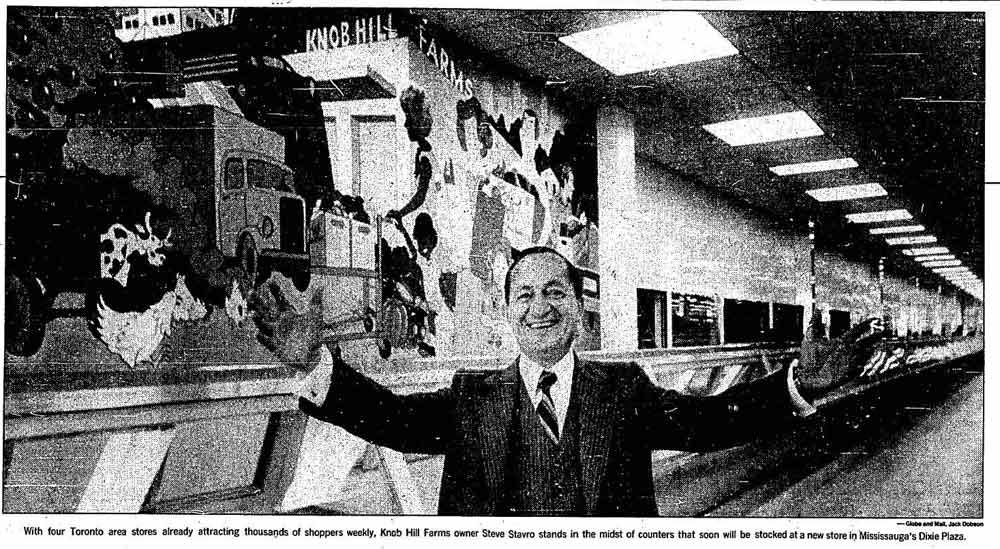This installment of my "Retro T.O." column for The Grid was originally published on April 10, 2012.
 |
| Cartoon by Patrick Corrigan, Toronto Star, December 7, 1990. |
It was an evening that should have been joyous for Canadian television. But as the Gemini Awards ceremony ended on December 4, 1990, the audience learned of an ominous announcement on that night’s edition of
The National. The hosts of
Monitor—the Gemini-nominated investigative-news series that aired on Toronto’s CBC affiliate, CBLT—stood arm-in-arm as they watched a story indicating that CBC would slash $110 million from its budget by closing 10 regional TV stations and cutting 1,200 employees. It was believed that Monitor was among the shows that would get the axe, an event for which co-host Jeffrey Kofman seemed prepared. “Toronto is already well served by the media,” he told the
Star. “I’ve had five great years. I’ll survive.” The punctured mood was summed up by Peter Mansbridge, who found it difficult to enjoy his Best Broadcast Journalist award “when I know a lot of my colleagues will be losing their jobs.”
The following afternoon, later known as “Black Wednesday,” CBC television employees watched president Gérard Veilleux deliver the bad news. He blamed the cutbacks on a recession-induced ad revenue drop and years of reduced federal subsidies. On television, CBC would exit local coverage and focus on national and regional concerns. The damage to CBLT was 100 layoffs and the immediate cancellation of all local production, which included
Monitor, weekly arts roundup
Toronto After Hours, weekend gardening show
Anything Grows, and special programming. Surviving newscasts at six and 11 would be produced by the national news unit and cover an area stretching to Windsor due to the demise of news operations in that market. While teary-eyed employees absorbed the details, CBC vice-president of English programming Denis Harvey, on crutches due to a knee operation, appeared in the CBLT lobby and called the layoffs “a terrible decision, a tragic decision.”
 |
| Cartoon by Brian Gable, Globe and Mail, December 6, 1990. |
At Toronto’s French CBC station, CBLFT, staff quietly booed Veilleux when he claimed to suffer many sleepless nights mulling the cuts. Employees of CBLFT had little sympathy: The station became a transmitter for Ottawa’s CBOFT, resulting in 60 job losses.
Anger was directed at Prime Minister Brian Mulroney and the federal Progressive Conservatives, who were perceived to have a vendetta against the CBC. Veteran CBLT cameraman Charles Tuzi believed the wrath of the feds was due to an exposé of tainted tuna sales on
The Fifth Estate in 1985—“ever since then,” he told the
Star, “Mulroney has gone nuts on us.” News anchor Hilary Brown told the
Sun that “I don’t think those Philistines in Ottawa understand how important regional programming is. They’ve got our heads on a platter.” Some Tory MPs confided to Sun Parliament Hill columnist Douglas Fisher that the party loathed the CBC and wanted it punished for criticizing the government.
Local-media reaction was mixed. The
Globe and Mail believed the cuts would make the CBC a strong broadcaster specializing in high-quality popular programs like
Degrassi High,
Road to Avonlea and
Danger Bay that told Canadians “about themselves in a uniquely Canadian manner.” The
Sun was sympathetic to local job losses, but thought there was too much whining about the cuts (“every Canadian has to learn to live within a budget”). The
Star demonstrated its outrage through editorial headlines like “A national disgrace.” The cuts were viewed within a trend of cutting or privatizing public corporations like Air Canada, Canada Post, Petro-Canada, and Via Rail. The paper questioned talk of a “renaissance for CBC,” pointing out the absurdity of southwestern Ontario sharing interests and perspectives as Toronto in local news coverage.
 |
| Cartoon by Andy Donato, Toronto Sun, December 6, 1990. |
Despite lawsuit threats from unions and municipalities, including legal advice sought by Toronto City Council for a court challenge to restore CBLFT, the cuts remained in effect for years. As ratings suffered, CBC gradually phased out the regional-news model in Toronto, which
Star entertainment Sid Adilman had predicted. “In this age of internationalism, where walls come crashing down and trade barriers are legislated out of existence, do we care about local events anymore? Ironically, this is when we turn to them most.”
Additional material from the December 6, 1990 edition of the Globe and Mail, the December 5-8, 1990 editions of the Toronto Star, and the December 6-7, 1990 editions of the Toronto Sun.
Bonus material: Coverage of the initial impact of the cuts in Windsor, which decimated the local CBC television operation. As the presence of private Canadian broadcasters was limited at the time (cable was only beginning to make inroads in Essex County, and the closest private Canadian station was London's CFPL), the decision effectively left the Windsor area without a local TV newscast for years.
Neither my father nor I were impressed by the Toronto-based replacement for local news, for reasons outlined in the editorial cartoon below; for 6:00 p.m. I think we alternated between Detroit's WDIV and WXYZ.
(And yeah, I coloured in the
Windsor Star logo on these scans...)
Click on any of the following images for larger versions.
 |
| Windsor Star, December 5, 1990. |
 |
| Windsor Star, December 5, 1990. |
 |
| Windsor Star, December 6, 1990. |
 |
| Windsor Star, December 6, 1990. |
 |
| Windsor Star, December 6, 1990. |
 |
| Windsor Star, December 6, 1990. |












Comments